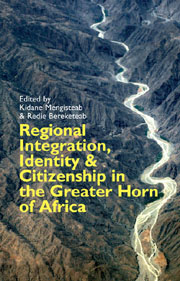Book contents
- Frontmatter
- Contents
- List of Tables, Figures & Appendices
- Notes on Contributors
- Acknowledgements
- List of Acronyms
- Part One RELEVANCE OF INTEGRATION TO IDENTITY AND CITIZENSHIP
- Part Two CRITICAL FACTORS IN INTEGRATION
- Part Three LESSONS FROM SELECTED AFRICAN INTEGRATION SCHEMES
- 8 Inter-Governmental Authority on Development (IGAD): A Critical Analysis
- 9 The East African Community: Can it be a Model for Africa's Integration Process?
- 10 The Economic Community of West African States (ECOWAS) and the Quest for Community Citizenship: Any Lessons for the Greater Horn Region?
- Index
- EASTERN AFRICAN STUDIES
8 - Inter-Governmental Authority on Development (IGAD): A Critical Analysis
from Part Three - LESSONS FROM SELECTED AFRICAN INTEGRATION SCHEMES
Published online by Cambridge University Press: 05 February 2013
- Frontmatter
- Contents
- List of Tables, Figures & Appendices
- Notes on Contributors
- Acknowledgements
- List of Acronyms
- Part One RELEVANCE OF INTEGRATION TO IDENTITY AND CITIZENSHIP
- Part Two CRITICAL FACTORS IN INTEGRATION
- Part Three LESSONS FROM SELECTED AFRICAN INTEGRATION SCHEMES
- 8 Inter-Governmental Authority on Development (IGAD): A Critical Analysis
- 9 The East African Community: Can it be a Model for Africa's Integration Process?
- 10 The Economic Community of West African States (ECOWAS) and the Quest for Community Citizenship: Any Lessons for the Greater Horn Region?
- Index
- EASTERN AFRICAN STUDIES
Summary
INTRODUCTION: HISTORICAL BACKGROUND
The Intergovernmental Authority on Drought and Development (IGADD) was established in 1986 comprising Ethiopia, Djibouti, Kenya, Somalia, Sudan and Uganda. The circumstances giving rise to the formation of IGADD were the rampant drought and desertification that was ravaging the region (IGAD, 1996). Since the early 1970s the region has been experiencing pervasive and severe droughts such as those of 1974 and 1984. These droughts inevitably generated extreme environmental degradation, desertification, deforestation and famine, making livelihoods in the region extremely precarious. The famine of 1984/85 which was of a cataclysmic magnitude wrought an unimaginable destruction of life in the form of death of animals and humans, huge internal displacement of people (IDPs), migration of others to neighbouring countries and immense human suffering (Woodward, 2004: 472; El-Affendi, 2001). The cataclysmic famine visited the region again in the summer of 2011, afflicting Somalia, Kenya and Ethiopia. The foundation of the regional organization was motivated by the idea of resolving common problems through collective efforts, and was launched at a summit in Djibouti in January 1986.
Driven by the immense hardships, the states of the six countries with the help of the United Nations (UN) and international donor groups, initiated the creation of an institutionalized action to control desertification and minimize the effects of droughts on life and induce development. Indeed ‘the states of the region were urged to form an intergovernmental authority to co-ordinate the fight against drought and famine. Several resolutions to this effect were passed by the UN General Assembly, starting with Resolution 35/90 of December 1980’ (El-Affendi, 2001: 582).
- Type
- Chapter
- Information
- Publisher: Boydell & BrewerPrint publication year: 2012



